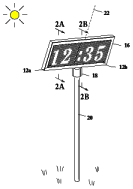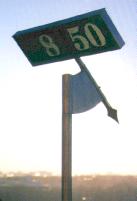
|
| Digital Sundials International |
|
Background
In 1991, Scientific American author Ian Stewart (based on a 1987
article by K. Falconer) hypothesized the possibility of a digital
sundial in an article entitled "What in heaven is a
digital sundial?" Inspired by this, the three inventors Hans
Scharstein, Daniel Scharstein, and Werner Krotz-Vogel set out to make
Stewart's fictitious clock a reality. The world's first prototype was
constructed in the summer of 1994 in Germany, and the invention was
patented in Germany and in the USA. The elegant designs of both large
and small sundials were developed by artist and engineer
Felix Scharstein, who joined the team in 1995.
The first digital sundial in a public place was erected in a sundial
park in Genk, Belgium, in 1998.
The digital sundial was also a
semifinalist in Hammacher Schlemmer's 1997 Search for
Invention contest.
Two large public digital sundials can be found in Germany: one in the
sundial exhibition in Germany's premier science museum, the
"Deutsches Museum" in Munich; and one on the roof of the Kölnisches
Stadtmuseum in Cologne, Germany. The first large digital sundial
in the USA was erected in the summer of 2002 in front of the
Corbin-Norton house on the corner of Ocean Park in Oak Bluffs,
Martha's Vineyard.
Besides building large custom-made sundials, we
also developed a small version of the digital sundial. It
took many years to develop a production process with the necessary
accuracy, but in 2001 we introduced our affordable indoor model, which is available
for sale on this web site.
For more information about large custom-made digital sundials, please
send email to 
|





 English
English
